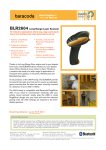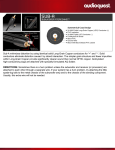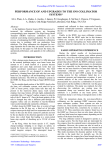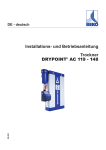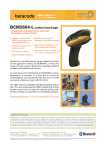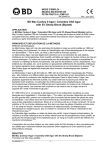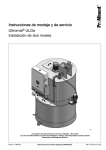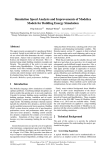Download Troubleshooting Status for the ALS In
Transcript
Proceedings of PAC09, Vancouver, BC, Canada MO6PFP087 TROUBLESHOOTING STATUS FOR THE ALS IN-VACUUM INSERTION DEVICE∗ A. Madur, S. Marks, S. Prestemon, D. Robin, T. Scarvie, R. Schlueter, C. Steier, LBNL, Berkeley, CA 94720, USA Abstract INITIAL OBSERVATIONS In 2006, the 30mm period In-Vacuum Insertion Device (IVID) was operational for the femtosecond phenomena beamline at the Advanced Light Source (ALS) of Lawrence Berkeley National Laboratory. Since routine operation began a series of partial or total beam losses as well as coincident sudden pressure increases within the IVID vacuum system have occurred while changing the IVID gap. This paper reports these observations and describes the investigations and the repair attempt performed on this insertion device. INTRODUCTION The Advanced Light Source (ALS) at Lawrence Berkeley National Laboratory installed and commissioned its first In-Vacuum Insertion Device (IVID) in 2006. The IVID was designed and built by the Neomax Corp. [1] as a collaboration with the Spring8 insertion device group [2]. This IVID is dedicated to two femtosecond phenomena beamlines [3]. Figure 1 shows a picture of the IVID. Events Description Beam losses as well as pressure bursts were observed while the IVID was operating at small gaps. This occurred particularly for currents above 200 mA and up to the maximum ALS current of 500 mA. Because of the rapid nature of the observed beam losses, it was impossible to distinguish between the cause and effect relationship of beam loss and pressure spike. Below are listed the causes we considered: • • • • mechanical obstacles, damaged conductive foils, misbehaving RF fingers, bad contacts, overheating conducting foil: vibrations during motion, misalignment, bad thermal conduction, • release of particles due to friction between two moving surfaces in contact: bellows, cooling parts of the transition pieces Components Likely Related to Beam Loss Figure 1: ALS In-Vacuum Insertion Device The IVID is 2.05 m long, 30 mm period hybrid planar undulator (Permanent magnet + iron poles) with a minimum operation gap of 5.5 mm (1.52 T). While operating at smaller gaps, beam losses (total or partial) have been associated with IVID gap movement. To address this issue and to understand this unexpected behavior, we started investigating all the possible causes. This paper reports the observations we performed, a review of the conductive foil replacement, and the experiments performed during accelerator physics shifts after the conductive foil replacement. ∗ This work was supported by the Director, Office of Science, U. S. Department of Energy under Contract No. DE-AC02-05CH11231. The magnetic structure is located within the vacuum chamber and a 110µm thick Cu-Ni conductive foil is installed over both magnetic structures (top and bottom) to ensure the conductive continuity of the image currents. This conductive foil is 110 mm wide and covers the magnets over the whole length (1.5 m). The Cu-Ni foil was obtained from a 60 µm thick sheet of copper, plated with nickel (50µm). The magnetic properties of the nickel are used to ensure adhesion of the foil to the magnets; this provides the heat conduction path for foil cooling. At both ends, the foils are clamped to the water-cooled transition taper plates made of OFHC copper (Oxygen-Free High Conductivity). These taper plates along with the sliding contacts ensure the transition between the fixed gap vacuum chamber and the undulator varying gap for the continuity of the image currents. Figure 2 shows the transition we just described. INITIAL DIAGNOSTICS First Inspection In spite of the initial observations (beam losses + pressure bursts) we lacked instrumentation to properly diagnose these issues. During the May 2008 ALS shutdown, we inspected the interior of the IVID with a borescope connected to a digital video camera. The borescope we used is rigid Magnets T15 - Undulators and Wigglers 333 MO6PFP087 Proceedings of PAC09, Vancouver, BC, Canada chlorine, chromium, cobalt, copper, iridium, iron, lead, magnesium, molybdenum, nickel, oxygen, potassium, silicon, sulfur, titanium and zinc. The presence of copper and nickel is consistent with our interpretation from the Fig. 3 i.e. deterioration of the conductive foil. After several discussions with Spring8 [2] and colleagues from the insertion devices community, we decided to replace the conductive foils. Cu Taper plates Sliding contacts e− beam Replacement of the Cu-Ni Foils IVID Entrance Figure 2: Transition parts between vacuum chamber flange and IVID gap (from left to right) - Cooling lines are not shown on this picture and is 80 mm long. Since we could only access the interior from the viewport windows, we inspected the ends region. These regions include the transition plates, the RF fingers and the extremities of the undulator i.e. the conducting foil installed on top of the magnets. From the ends we had a global view of the inside of the IVID vacuum chamber. From the inspection we determined the following: • no discoloration on the sliding contacts: they are not overheating, • no discoloration on each part of the transition regions, • some small scratches (order of 1 mm wide) and some wrinkles on the conductive foil, • an important discoloration around one hole on the conductive foil; the foil is designed with pairs of 2 mm diameter holes distributed longitudinally near the outer edges in order to get a flat surface on the foil (no trapped volume) after its installation, • some dust deposition; this dust is aligned with the transverse edges of the magnets. We replaced the conductive foil in collaboration with the device manufacturer, Hitachi-Neomax [1] during the September 2008 ALS shutdown. With the help of three qualified technicians from Japan, we managed to remove the IVID from the ALS storage ring, replace the conductive foils and re-install the IVID within four weeks. The conductive foils replacement also provided an opportunity to directly inspect the IVID. The main observation from this work is that the conductive foil seemed to be in good shape; the scratches were relatively small and to be acceptable; they likely occurred during the initial IVID assembly. The picture of the discoloration around the hole (Fig. 3) was actually showing an extra layer of nickel. During the plating process, it sometimes happens that some nickel material overflows to the copper side. Consequently no copper was missing at that location and the presence of nickel on the copper side does not affect the conductive foil quality. While inspecting the “old” foils, we also noticed tiny brown spots that were randomly spaced all along the foil. It was not possible to tell if they were the result of the original fabrication or if they have been generated by vaporized pieces of dust. COMMISSIONING AND ACCELERATOR PHYSICS SHIFT OBSERVATIONS Commissioning Figure 3: Pictures from inspection. Left: discoloration and missing copper around a hole. Middle: dust deposited along magnet edges. Right: Line of dust and a scratch on the surface (shiny spot) The left picture from Fig. 3 captured our attention. Our interpretation of this picture was that it showed copper peeling off and cracking due to heat induced stress. Moreover we collected some samples of the dust in order to analyze it. The analysis has been performed by Evans Analytical Group (EAG) [4] using the Energy Dispersive X-ray Spectroscopy method to determine the dust composition. The dust materials include: aluminum, carbon, After the foil replacement and the installation of the IVID back in the ALS storage ring, the IVID was again commissioned. The result of the commissioning demonstrated that the beam dynamics in term of tune, lifetime, dipole errors and beam size instability were not affected with the attempted repair. We checked the IVID vertical alignment with the electron beam and found an offset of 200 µm which is similar to the one measured before the conductive foil replacement. An alignment of the IVID will be scheduled in the near future in order to have a balanced beam clearance and heat deposition between the top and bottom conductive foils. Following re-installation of IVID in the ALS storage ring, it took more than three months to achieve the desired vacuum performance, 10 −11 Torr range (10 −9 Pa). Thermal outgassing was the result of image current heating and upstream synchrotron radiation dissipating in the conductive foils. This issue has prevented us from operating at Magnets 334 T15 - Undulators and Wigglers Proceedings of PAC09, Vancouver, BC, Canada MO6PFP087 small gaps and we had to limit the operational gap to 10 mm for initial operation. Beam losses and pressure bursts were again observed at smaller gaps . Although the conductive foil replacement improved our knowledge concerning the state of the IVID, it did not resolve the issue of the spurious beam losses and pressure bursts. We are dedicating some time during the accelerator physics shifts to continue investigating the probable causes of our problems. We are continuing our efforts to track the instability source(s). One of them could be the dust deposited on the IVID conductive foils. We are investigating the possibility to isolate the IVID vacuum during maintenance operations by adding a vacuum valve. If the dust particle source is located beyond the IVID, such a valve may reduce deposition of these particles within the IVID. Accelerator Physics Shifts The list of possible causes for beam instability associated with IVID operation is getting shorter but this is still a work in progress. Future investigations include a plan to tune the feedback system to make the beam less stable and consequently more sensitive to any instability. The purpose is to be able to reproduce the beam losses we experience so that we can increase event statistics and hopefully identify their cause(s). We also plan to use a fast oscilloscope triggered right after a beam loss to determine the speed of propagation of the instability. Troubleshooting the IVID to allow it to operate at small gaps has become an unexpectedly long project. While we are continuing our investigations, we are still learning about its behavior. The random nature of the instabilities makes it difficult to methodically study the problem. Improved diagnostics will aid in determining and eliminating the source of losses. As the statistics for beam losses events was small and the reproducibility of such events was not evident, the goal of the dedicated accelerator physics shifts is to find the conditions that consistently trigger these events. Gap motion We focused our initial attention to the gap motion. Most of the events were indeed observed while the IVID gap was changing and only in the closing direction. Since we were not able to close the IVID to small gaps directly (≤ 9mm) consistently without beam loss, we tried to find a process that would allow us to reach any desired gap without beam losses. We closed the IVID gap by small steps (100µm) from 9.5mm to 5.5mm gaps at a speed of 1 mm/s, waiting for the vacuum to recover between each step. We repeated this experiment twice and both experiments were conducted at high beam current (500 mA and 440 mA). Beam losses from the mA range to the 100 mA range were observed and they occurred at similar gaps for both experiments except for the 5.5 mm gap. At this gap, the speed was different for each experiment and and a beam loss was observed at the highest speed (1 mm/s vs 0.1 mm/s). When the beam losses occurred, some vacuum activity was observed (ΔP max = 11.10−10 Torr) but it seems to be too small to likely cause the beam losses. One important observation we made during this shift is that when the beam losses occurred, we could see through the synchrotron radiation monitor that the beam was blowing up in the vertical direction before recovering its normal shape in the cases of partial beam losses. CONCLUSION ACKOWLEDGMENT We would like to thank Spring8 and Hitachi-Neomax colleagues for the fruitful collaboration. REFERENCES [1] Hitachi-Metals company, metals.co.jp/e/index.html Neomax, http://www.hitachi- [2] Spring 8, http://www.spring8.or.jp/en/ [3] C. Steier, P. Heimann, S. Marks, R. Schoenlein, W. Wan, W. Wittmer, Successful completion of the femtosecond slicing upgrade at the ALS, PAC 07 [4] Evans Analytical Group (EAG), http://www.eaglabs.com/ Closing to minimum gap When the IVID vacuum became good enough (10 −11 Torr range (10 −9 Pa)) we could manage to close it to the minimum gap gradually. This important step allowed us to dedicate some time to scrubbing and thus improving the IVID vacuum. However, one of the first times we left the IVID at the minimum gap, we saw sudden pressure spikes happening without beam loss. Then we were able to close the IVID to the minimum gap directly without experiencing any beam losses except for one particular case. The first successful attempts to close the gap were performed while the orbit feedback was on and all the insertion devices where wide open. When we performed the same experiment with all the insertion devices closed, we experienced a partial beam loss between the 6 mm and 5.5 mm gaps. Magnets T15 - Undulators and Wigglers 335



